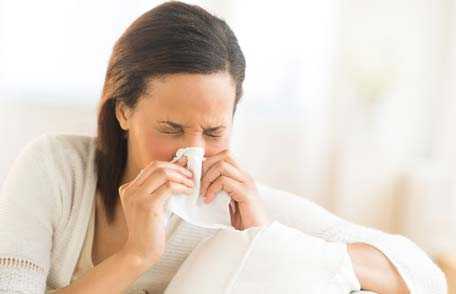Common Colds: Protect Yourself and Others
 Sore throat and runny nose are usually the first signs of a cold, followed by coughing and sneezing. Most people recover in about 7-10 days. You can help reduce your risk of getting a cold: wash your hands often and avoid touching your face with unwashed hands.
Sore throat and runny nose are usually the first signs of a cold, followed by coughing and sneezing. Most people recover in about 7-10 days. You can help reduce your risk of getting a cold: wash your hands often and avoid touching your face with unwashed hands.
Common colds are the main reason that children miss school and adults miss work. Each year in the United States, there are millions of cases of the common cold. Adults have an average of 2-3 colds per year, and children have even more.
Most people get colds in the winter and spring, but it is possible to get a cold any time of the year. Symptoms usually include:
- sore throat
- runny nose
- coughing
- sneezing
- headaches
- body aches
Most people recover within about 7-10 days. However, people with weakened immune systems, asthma, or respiratory conditions may develop serious illness, such as pneumonia.
How to Protect Yourself
Viruses that cause colds can spread from infected people to others through the air and close personal contact. You can also get infected through contact with stool (poop) or respiratory secretions from an infected person. This can happen when you shake hands with someone who has a cold, or touch a doorknob that has viruses on it, then touch your eyes, mouth, or nose.

Help reduce your risk of getting a cold by washing hands often with soap and water.

Practice good cough and sneeze etiquette: always cough and sneeze into a tissue or your upper shirt sleeve, completely covering your mouth and nose.
You can help reduce your risk of getting a cold:
- Wash your hands often with soap and water
Wash them for 20 seconds, and help young children do the same. If soap and water are not available, use an alcohol-based hand sanitizer. Viruses that cause colds can live on your hands, and regular handwashing can help protect you from getting sick. - Avoid touching your eyes, nose, and mouth with unwashed hands
Viruses that cause colds can enter your body this way and make you sick. - Stay away from people who are sick
Sick people can spread viruses that cause the common cold through close contact with others.
Help reduce your risk of getting a cold by washing hands often with soap and water.
How to Protect Others
If you have a cold, you should follow these tips to prevent spreading it to other people:
- Stay at home while you are sick
- Avoid close contact with others, such as hugging, kissing, or shaking hands
- Move away from people before coughing or sneezing
- Cough and sneeze into a tissue then throw it away, or cough and sneeze into your upper shirt sleeve, completely covering your mouth and nose
- Wash your hands after coughing, sneezing, or blowing your nose
- Disinfect frequently touched surfaces, and objects such as toys and doorknobs
There is no vaccine to protect you against the common cold.
Practice good cough and sneeze etiquette: always cough and sneeze into a tissue or your upper shirt sleeve, completely covering your mouth and nose.
How to Feel Better
There is no cure for a cold. To feel better, you should get lots of rest and drink plenty of fluids. Over-the-counter medicines may help ease symptoms but will not make your cold go away any faster. Always read the label and use medications as directed. Talk to your doctor before giving your child nonprescription cold medicines, since some medicines contain ingredients that are not recommended for children. Learn more about symptom relief of upper respiratory infections, including colds.
Antibiotics will not help you recover from a cold. They do not work against viruses, and they may make it harder for your body to fight future bacterial infections if you take them unnecessarily. Learn more about when antibiotics work.
When to See a Doctor
You should call your doctor if you or your child has one or more of these conditions:
- a temperature higher than 100.4° F
- symptoms that last more than 10 days
- symptoms that are severe or unusual
If your child is younger than 3 months of age and has a fever, you should always call your doctor right away. Your doctor can determine if you or your child has a cold and can recommend therapy to help with symptoms.
Causes of the Common Cold
Many different viruses can cause the common cold, but rhinoviruses are the most common. Rhinoviruses can also trigger asthma attacks and have been linked to sinus and ear infections. Other viruses that can cause colds include respiratory syncytial virus, human parainfluenza viruses, and human metapneumovirus.
- Page last reviewed: February 6, 2017
- Page last updated: February 6, 2017
- Content source:
- National Center for Immunizations and Respiratory Diseases, Division of Viral Diseases
- Page maintained by: Office of the Associate Director for Communication, Digital Media Branch, Division of Public Affairs




 ShareCompartir
ShareCompartir